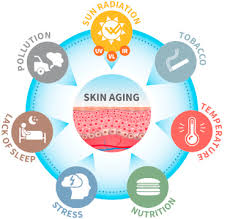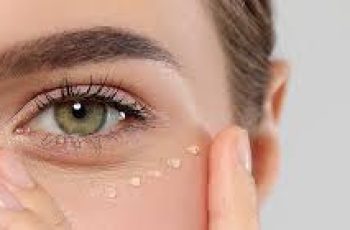
What Are The Causes of Aging Skin?
What is the cause of aging skin? Skin aging, characterized by wrinkles, sagging, and thin skin has many causes. The causes of skin aging are often divided into intrinsic and extrinsic causes. This guide to the major causes of skin aging will discuss the science of what makes skin look old.
This guide to the aging process will continuously be updated as new discoveries about skin aging are made. For more detailed explanation about skin aging see Chapters 5 and 6 of the latest edition of my textbook Baumann’s Cosmetic Dermatology (McGraw Hill 2022).
Antiaging skin care ingredients target these specific processes that make skin old. There are many different types of antiaging ingredients and you should choose the ones that work best for your Baumann Skin Type.
Take the Quiz
16 Bauman Skin Types
Biologic Causes of Skin Aging
There are numerous cell processes that cause aging, that’s why treating aging can be difficult. There are so many metabolic pathways to target such as:
Cellular senescence
Autophagy
Free radicals (reactive oxygen species)
Inflammation
Short Telomers
Slowing of stem cell production of new cells
Decreased growth factors
Loss of ability for cells to “hear” growth factors
Changes in gene expression
Increases in destructive enzymes like matrix metalloproteinases such as collagenase
Sirtuin Expression
Mitochondrial function
To protect your skin from the causes of skin aging, you have many skin care product options. You should choose antiaging skin care based on your Baumann Skin Type.
Skin Aging Science
Senescent cells cause skin aging. Skin cells (keratinocytes and fibroblasts) go through five different cell phases:
Stem cells
Proliferating cells
Differentiated cells
Senescent cells
Apoptotic cells
Cellular Senescence and Autophagy
Apoptotic cells are “dead skin cells” and are not viable. They are are eliminated by autophagy and other processes that recycle cellular components. That is why apoptotic cells are not believed to be harmful to the skin.
However, the more senescent cells you have, the more likely your skin is to wrinkle and age.
Senescent cells have lost the ability to proliferate and lysosomes and mitochondria lose functionality and lose the ability for autophagy.(5) Senescent cells are not eliminated from the skin, and they stay and causes skin aging.
The presence of senescence cells is associated with an increased rate of aging . The goal of rejuvenating skin is to reduce the number of senescence cells by increasing autophagy.
Senescent cells develop into the senescence-associated secretory phenotype (SASP) which is believed to be one of the major causes of skin aging.
SASP cells cause damage and aging by releasing:
proinflammatory cytokines
matrix metalloproteinases (MMPs)
growth factors
chemokines
matrix-modeling enzymes
lipids
free radicals
extracellular vesicles (EVs)
Release of these substances by senescent cells causes inflammation, known as “inflammaging (9)”. This inflammation causes many problems such as loss of collagen, elastin and extracellular matrix (ECM) which leads to fibroblast compaction, reduced DNA synthesis, and eventually wrinkles, fragile skin and thin skin.
Autophagy is the important process in which organelles such as lysosomes and mitochondria(6) self-digest or “eat themselves”. Autophagy eliminates problem causing organelles and cells like damaged mitochondria, damaged lysosomes and senescent cells.
Sirtuins and Skin Aging
Activation of sirtuin (SIRT-1) has been shown to extend the lifespan in mammals. Caloric restriction (10) also activates sirtuin which is why intermittent fasting has become an antiaging strategy. SIRT-1 decreases senescence and activates autophagy.
How sirtuins affect skin aging
how free radicals age skin
How Do Free Radicals Cause Skin Aging?
Free radicals (1), also known as reactive oxygen species (ROS), are formed when oxygen molecules lose an electron and are left with an odd number of electrons. An oxygen molecule with paired electrons is stable; however, oxygen with an unpaired electron is “reactive” because it seeks and seizes electrons from vital components leaving them damaged.(2)
What causes free radicals to occur?
Free radicals are formed by:
damaged mitochondria
inflammation
normal cell metabolism
pollution
smoking
ultraviolet light
Normal cellular metabolism can result in free radical formation. Damaged mitochondria generate free radicals which is one reason why it is so important to protect your mitochondria with antioxidants.
Free radicals attack DNA, cellular proteins, and cellular membranes and steal electrons leaving these cellular components damaged. This can cause inflammation.
Free radicals increase amounts of:
inflammatory factors
transcription factors, such as activator protein (AP)-1
nuclear factor-κB (NF-κB)
matrix metalloproteinases (MMPs) such as collagenase, which degrades skin collagen
Destructive Enzymes and Skin Aging
Groups of destructive enzymes that cause aging are called matrix metalloproteinases or MMPs. MMPs are turned on by genes, inflammation and exposure to ultraviolet light and pollution.
Examples of destructive enzymes that cause skin aging are:
Collagenase breaks down collagen
Elastase breaks down elastin
Hyaluronidase breaks down hyaluronic acid.
enzymes that age skin
Short Telomeres and Skin Aging
Telomeres are composed of small pieces of repetitive DNA sequences at the ends of chromosomes. These control the cell cycle. Each cell division shortens the telomere.
Telomere shortening may cause aging by triggering cellular senescence,(13) however, the role of telomere shortening in senescence is unclear.
Why are telomeres short? These are believed to play a role in telomere shortening:
free radicals
physiologic stress
inflammation
Genes That Cause Skin Aging and Wrinkles
Research is shedding light on which genes are important in skin appearance and function, but it is still many years too early to develop skin care products targeted to “genetic deficiencies”. Glass et al (20) showed that gene studies on aging must be done in human skin to be relevant. Genetic studies on animals and cell cultures do not tell us what we need to know about human genes that cause aging.
Aged skin has increased expression of inflammation-related genes, cytokines and proteases.
Genes that cause skin aging (21) are involved in:
cellular metabolism
DNA transcription
signal transduction
cell cycle regulation
epidermal differentiation,
keratin filaments
cornified envelope proteins
lipid biosynthesis
skin barrier integrity
mitochondrial function
cytokine production
immune response
Aging research is still in the early stages, but the pace of discovery has quickened. I will update this guide to the science of skin aging as new discoveries are found. But at this time, don’t waste money on skin care that claim to target the genes that cause skin aging. It is too early for us to completely understand what genes to target with antiaging skin care.
How Inflammation Causes Skin Aging
When skin gets inflamed, many destructive pathways get turns on known as inflammaging. Free radicals, destructive enzymes like matrix metalloproteinases, and immune cells all cause skin damage in inflamed skin that leads to aging. Build up of senescent cells also occurs. To prevent skin aging it is important to identify and remove the causes of skin inflammation and to turn off inflammation with anti-inflammatory skincare ingredients.
Using the wrong skin care products can cause skin inflammation.
Cosmeceutical Antiaging Skincare Ingredients Should Target the Causes of Skin Aging
Retinoids, growth factors, exosomes, defensins, antioxidants, heparan sulfate and ascorbic acid are all antiaging ingredients used to target the causes of aging skin.
The causes of skin aging are complicated. The best way for you to choose antiaging skincare that is right for you is to shop using your Baumann Skin Type.


